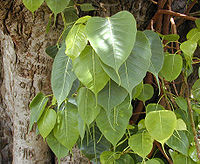
A hypothesis to explain accuracy of wasp resemblances
Sign Up to like & getrecommendations! Published in 2017 at "Ecology and Evolution"
DOI: 10.1002/ece3.2586
Abstract: Abstract Mimicry is one of the oldest concepts in biology, but it still presents many puzzles and continues to be widely debated. Simulation of wasps with a yellow‐black abdominal pattern by other insects (commonly called… read more here.
Keywords: insects; explain accuracy; hypothesis explain; mimicry ... See more keywords

Rising temperatures threaten pollinators of fig trees—Keystone resources of tropical forests
Sign Up to like & getrecommendations! Published in 2022 at "Ecology and Evolution"
DOI: 10.1002/ece3.9311
Abstract: Abstract Pollinating insects are decreasing worldwide in abundance, biomass, and species richness, affecting the plants that rely on pollinators for fruit production and seed set. Insects are often sensitive to high temperatures. The projected temperature… read more here.
Keywords: fig trees; tropical forests; wasp; temperature ... See more keywords

Venom α-amylase of the endoparasitic wasp, Pteromalus puparum influences host metabolism.
Sign Up to like & getrecommendations! Published in 2020 at "Pest management science"
DOI: 10.1002/ps.5755
Abstract: BACKGROUND Pteromalus puparum (Hymenoptera: Pteromalidae) is an endoparasitoid wasp that parasitizes many butterfly species, including a Brassicaceae pest, Pieris rapae (Lepidoptera: Pieridae), the small white cabbage butterfly. P. puparum females inject venom along with their… read more here.
Keywords: host metabolism; metabolism; pteromalus puparum; influences host ... See more keywords

Genomes of the Banyan Tree and Pollinator Wasp Provide Insights into Fig-Wasp Coevolution
Sign Up to like & getrecommendations! Published in 2020 at "Cell"
DOI: 10.1016/j.cell.2020.09.043
Abstract: Banyan trees are distinguished by their extraordinary aerial roots. The Ficus genus includes species that have evolved a species-specific mutualism system with wasp pollinators. We sequenced genomes of the Chinese banyan tree, F. microcarpa, and a… read more here.
Keywords: pollinator wasp; banyan tree; tree pollinator; aerial roots ... See more keywords

A new wasp of Myanmarinidae (Hymenoptera: Stephanoidea) from the mid-Cretaceous Myanmar amber
Sign Up to like & getrecommendations! Published in 2018 at "Cretaceous Research"
DOI: 10.1016/j.cretres.2018.02.009
Abstract: Abstract A new myanmarinid wasp, Myanmarina jeannineae sp. nov., is described and figured from the mid-Cretaceous Myanmar (Burmese) amber. The new species is established based on one female and two male specimens, and the following… read more here.
Keywords: myanmarinidae hymenoptera; wasp; mid cretaceous; cretaceous myanmar ... See more keywords

Using a proteometabolomic approach to investigate the role of Dufour's gland in pheromone biosynthesis in the social wasp Polybia paulista.
Sign Up to like & getrecommendations! Published in 2017 at "Journal of proteomics"
DOI: 10.1016/j.jprot.2016.01.009
Abstract: Dufour's gland is associated with the venom apparatuses of social wasps and bees. This location and its evolutionary adaptations indicate that it could be involved in the production of alarm pheromones in the social wasp… read more here.
Keywords: dufour gland; biosynthesis; alarm pheromones; gland ... See more keywords

Revisiting Polybia paulista wasp venom using shotgun proteomics - Insights into the N-linked glycosylated venom proteins.
Sign Up to like & getrecommendations! Published in 2019 at "Journal of proteomics"
DOI: 10.1016/j.jprot.2019.03.012
Abstract: The partial proteome of Polybia paulista wasp venom was previously reported elsewhere using a gel-dependent approach and resulted in the identification of a limited number of venom toxins. Here, we reinvestigated the P. paulista venom… read more here.
Keywords: wasp venom; venom; polybia paulista; venom proteins ... See more keywords

Inhibition of N-WASP affects actin-mediated cytokinesis during porcine oocyte maturation.
Sign Up to like & getrecommendations! Published in 2020 at "Theriogenology"
DOI: 10.1016/j.theriogenology.2020.01.005
Abstract: N-WASP is the mammalian ortholog of WASP which is an actin nucleation promoting factor and has been reported to regulate actin nucleation and polymerization for multiple cell activities. However, the expression and functions of N-WASP… read more here.
Keywords: oocyte maturation; inhibition; porcine; wasp ... See more keywords

Targeting the actin nucleation promoting factor WASp provides a therapeutic approach for hematopoietic malignancies
Sign Up to like & getrecommendations! Published in 2021 at "Nature Communications"
DOI: 10.1038/s41467-021-25842-7
Abstract: Cancer cells depend on actin cytoskeleton rearrangement to carry out hallmark malignant functions including activation, proliferation, migration and invasiveness. Wiskott–Aldrich Syndrome protein (WASp) is an actin nucleation-promoting factor and is a key regulator of actin… read more here.
Keywords: nucleation promoting; hematopoietic malignancies; actin nucleation; promoting factor ... See more keywords

Completely predatory development is described in a braconid wasp
Sign Up to like & getrecommendations! Published in 2022 at "Scientific Reports"
DOI: 10.1038/s41598-022-05705-x
Abstract: Hymenopteran parasitoids are well known for their ubiquitous diversity, important ecological roles and biocontrol potential. We report the first detailed documentation of mite predation by a parasitoid wasp, Bracon predatorius Ranjith & Quicke sp. nov.,… read more here.
Keywords: predatory development; braconid wasp; described braconid; completely predatory ... See more keywords

HST/STIS transmission spectrum of the ultra-hot Jupiter WASP-76 b confirms the presence of sodium in its atmosphere
Sign Up to like & getrecommendations! Published in 2020 at "Astronomy and Astrophysics"
DOI: 10.1051/0004-6361/201937169
Abstract: We present an atmospheric transmission spectrum of the ultra-hot Jupiter WASP-76 b by analyzing archival data obtained with the Space Telescope Imaging Spectrograph (STIS) on board the Hubble Space Telescope (HST). The dataset spans three… read more here.
Keywords: spectrum ultra; transmission; sodium; transmission spectrum ... See more keywords